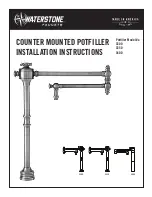
Installation
1. You will notice that the water inlet and diverter are at the top of the rail. A
standard ½” water supply lug should be positioned centrally in the shower area
and about 1800mm from the shower base subject to user preference.
2. Ensure that the ½” lug is not protruding from the wall more than 13mm. Remove
any debris or tile glue from the lug, wind sufficient thread tape onto the lug and
screw on the brass adaptor supplied using a 12mm hex wrench. Screw this on
until the back of the adaptor is almost touching the tiles.
3. Flush the water line by running a liberal amount of water into a bucket.
4. Accurately mark the position of the bottom bracket. Be sure to check the length
of the shower rail that you have received as there are 2 models, 600mm and
900mm. This measurement refers to the centre to centre dimension between
the top and bottom bracket. If the bottom bracket is located in this exact position
it will neatly cover the joint between the hose nut and the rail. The bottom
bracket can, however be mounted higher up if necessary as the rail can slide
through the bracket.
5. Drill the tiles and fit the plastic mount disc to the wall with the screw provided.
6. Now carefully remove the shower rail assembly and shower arm from the box.
You will notice that there is a threaded spigot protruding from the top of the top
bracket. Remove the black plastic protector cap from the spigot and screw the
shower arm onto the spigot.
The shower arm is designed to swivel.
Screw the
arm on
gently
until the thread bottoms.
Now unscrew it slightly
just enough to
allow it to rotate freely from left to right in use without bottoming out on the
thread.
7. Remove the cover flanges from the box and press one of these onto the top
bracket and the other onto the bottom bracket supplied in box.
8. Slide the bottom bracket just onto the bottom of rail oriented with the grub
screw hole to the bottom.
9. Hold the bottom bracket from sliding off and lift the whole assembly and press
it onto the wall over the top and bottom mount pieces. Make sure that the top is
pushed right back until it is almost touching the tiles.
10. Insert the small grub screws and fasten the shower to the mount lugs using the
small hex wrench supplied. Check that the shower is properly secured and
cannot come off the wall.
11. Press the cover flanges back against the tiles.
12. Loosen and rotate the slider bracket so that the handle knob is to the left. Rotate
the click action holder bracket so that the opening is to the back.
13. Remove the handshower and hose from the package and screw one end of the
hose to the handshower and the other end to the threaded bottom end of the rail
(Hand-tight only) Place the handshower in the holder bracket. Smooth PVC
hoses may take some time to settle into a natural hanging shape.
14. Remove the overhead shower from the box and carefully screw this onto the end
of the shower arm and tighten gently with shifting spanner.
15. Run the shower and test operation. The diverter knob is designed so that when
the pin faces up the water comes out of the overhead shower and when the pin
faces down it comes out of the handshower.
!
DO NOT OVER TIGHTEN
The shower arm is
designed to swivel.




















